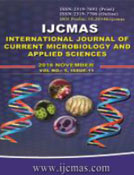


 National Academy of Agricultural Sciences (NAAS)
National Academy of Agricultural Sciences (NAAS)

|
PRINT ISSN : 2319-7692
Online ISSN : 2319-7706 Issues : 12 per year Publisher : Excellent Publishers Email : editorijcmas@gmail.com / submit@ijcmas.com Editor-in-chief: Dr.M.Prakash Index Copernicus ICV 2018: 95.39 NAAS RATING 2020: 5.38 |
In hospitalized patients with predisposing illnesses leads to the life threatening infections with Non-fermentative Gram negative bacteria (NFGNB) like Pseudomonas aeruginosa, Acinetobacter baumannii, Stenotrophomonas maltophilia and Burkholderia cepacia. The patients are placed at high risk because the NFGNB have high intrinsic antibiotic resistance. All consecutive, non-duplicate isolates of NFGNB were collected from various clinical samples like blood, sputum, tracheal aspirate, urine, pus etc. from hospitalised patients during the study period. The phenotypic identification of various isolates was done as per standard laboratory protocol and antibiotic susceptibility interpretation was done as per CLSI guideline 2015. Out of 420 isolates the predominant sample is sputum and the predominant isolate was Pseudomonas aeruginosa followed by Acinetobacter baumannii. From the total 420 isolates, the maximum resistance was to cefepime 62 (14.8%) followed by Ceftazidime 50 (12%) and Ceftazidime-clavulanic acid 50 (12%), colistin 20 (4.8%), piperacillin-tazobactam 18 (4.3%) and gentamicin 18 (4.3%), imipenem 13 (3.1%), ciprofloxacin 12 (2.8%) and amikacin 11 (2.6%). Some of the studies from India reported the predominant isolate was Pseudomonas and some as Acinetobacter. In relation to antibiotic resistance comparatively imipenem resistance was very less than other studies that may be due to less usage of carbapenems. The main projection from our study is proper identification of NFGNBs, drug holiday and judicial usage of third and fourth generation cephalosporins and carbapenems are very important. Also implementation maintenance of strict antibiotic policy can help to fight against drug resistance by HICC.
 |
 |
 |
 |
 |